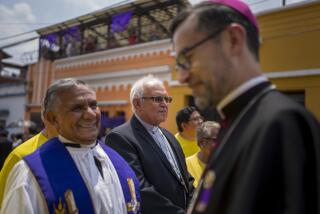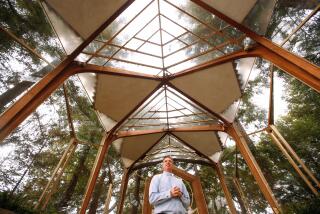Outrage Greets Huge New Managua Cathedral : Churches: Design is blasted as mosque-like. Critics say money, donated by Domino’s Pizza magnate, should go to health care and other services.
- Share via
MANAGUA, Nicaragua — Two hundred fifty workers began laying the foundation this month for a new Roman Catholic cathedral here. The start of construction of the mammoth structure has unleashed a storm of controversy about its design and political implications.
A wide range of Nicaraguans, including several prominent supporters of conservative Cardinal Miguel Obando y Bravo, have criticized the new cathedral--paid for by a U.S. pizza magnate--as an example of cultural imperialism.
The structure, to be built between two shopping centers on the southern edge of the capital, will replace the cathedral left in ruins by a December, 1972, earthquake that razed downtown Managua. The shell of the building is expected to be finished by October, 1992, when Catholic leaders here hope that Pope John Paul II will pay a visit.
The construction began despite fund-raising problems. Obando has come up with only a fraction of the $500,000 to be raised locally for the construction. Several fund-raising events here and in Miami have been unsuccessful.
President Violeta Barrios de Chamorro donated a Toyota sedan to be raffled off. In addition, Managua, which donated the 30-acre site, spent $160,000 to clear the property.
The remaining $2.5 million of the $3-million cost is being provided by Tom Monaghan, the owner of Domino’s Pizza. Monaghan, a Catholic, has long supported conservative causes in the region. Since the electoral defeat of the Sandinistas last year, he has made several trips to Nicaragua. According to Adolfo Miranda, a Baptist lawyer here, Monaghan, in bankrolling the cathedral, is “repaying the cardinal for his years of faithful opposition to the Sandinistas.”
Although Obando laid the cornerstone last July, the design of the structure was not made public until this June, when architect’s drawings were published in the pro-government daily La Prensa. The opposition was swift and apparently widespread.
Dozens of writers--including many prominent Catholics--condemned the building for looking like a mosque. Several days later, La Prensa ran a photo from a different angle, suggesting that readers had misinterpreted the first photos. It did not persuade the skeptics.
“That mosque is extremely exotic and too kitsch,” commented conservative poet Guillermo Rothschuh in an Aug. 6 editorial in La Prensa.
In a recent public forum sponsored by the Institute for Hispanic Culture, painter Leonicio Saenz called the building a “fortress” and a “symbol of power.” Porfirio Garcia, a professor of architecture at the Catholic Central American University here, termed the design “an example of exaggerated monumentalism.”
Gloria Garcia, an art professor at the same university, complained that the design “is in bad taste and of doubtful aesthetic quality.” She claimed that the structure “doesn’t correspond to the Christian mysticism of our people, nor of Hispanoamerica.”
The cathedral’s roof line, made up of 63 small domes with a large, rectangular tower to one side, became the target of satire. The weekly Semana Comica lampooned the structure, contending that it offended fundamentalist evangelicals because it resembled certain parts of the male and female anatomy.
The Rev. Bismark Carballo, Obando’s public relations representative, said the rash of criticism is based only on the architect’s sketches. He encouraged critics to wait for the result, especially the interior of the structure, before passing judgment.
The controversy concerns not just the building’s design, but also the selection of the architect.
Several Nicaraguan architects have expressed dismay that the building was designed by Mexican architect Ricardo Legorreta. They claim the process ignored the talent and shortage of work among Nicaraguan architects. “Our architects were ignored and discriminated against by not being taken into consideration for the project,” wrote Mario Borge in La Prensa.
Rothschuh termed the cathedral’s design “cultural filibusterism,” with “elements foreign to our cultural identity.” He claimed that the Mexican architect’s design “would never have been accepted by Mexican nationalists.”
Obando’s auxiliary, Bishop Leopoldo Brenes, defended the choice of architect, who was reportedly selected by Monaghan. “You don’t inspect the teeth of a gift horse,” he told the opposition weekly El Semanario.
Managua’s mayor, Arnoldo Aleman, a member of the cathedral’s fund-raising committee, agreed, saying it does not matter whether citizens like the mosque-like cathedral. “The decisions are made by those who pay the bills,” he said.
A group of poor residents threatened with eviction has also criticized the project. Sixteen families, who live along the eastern edge of the cathedral site, claim that city officials have warned them to move or be removed by force. They point out that Aleman sent bulldozers to destroy several dozen houses in the center of the city during February; they fear the same fate awaits them.
The new cathedral has drawn fire for its high cost at a time when Nicaragua is experiencing an economic crisis. According to United Nations figures, 54.5% of Managua’s 1.3 million people live in crowded conditions without access to such services as health care, education, potable water and electricity. Half of the city’s economically active population is unemployed and poor neighborhoods are bracing for the outbreak of cholera predicted by health officials.
“Why are we building a new cathedral instead of latrines and potable water systems?” asked Miranda.
The cardinal has stayed out of the commotion. He continues celebrating Mass every Sunday at a small church in Las Sierritas, an exclusive neighborhood in the hills south of Managua.
More to Read
Sign up for Essential California
The most important California stories and recommendations in your inbox every morning.
You may occasionally receive promotional content from the Los Angeles Times.










